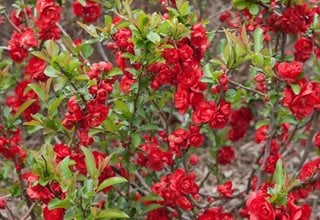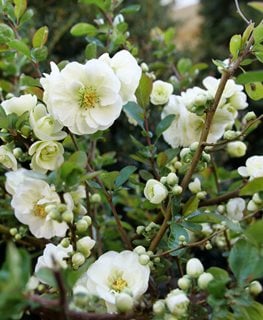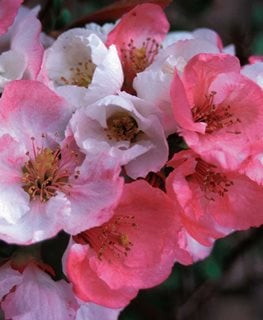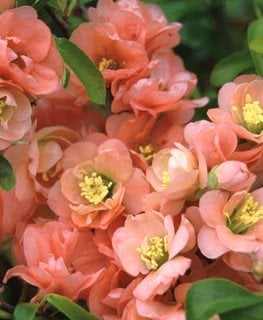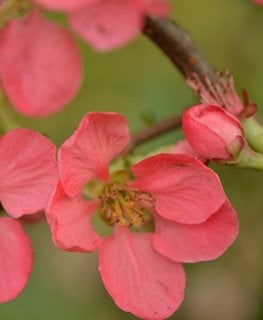Flowering Quince - Get a Jumpstart on Spring Flowers
One of the first garden shrubs to bloom in spring, flowering quince banishes the winter doldrums with its bright, colorful flowers.If one word could be used to describe the glories of flowering quince, it would be “apricity,” a quaint but little-used term that means the warmth of the sun in winter. Bravely defying the chill of late winter, flowering quince (Chaenomeles) wakes from a long slumber to put on a dazzling display of apple-blossom-like flowers in an array of bright and cheery colors.
Flowering quince blooms weeks before other spring-flowering shrubs—even forsythia— appearing as early as late January in the South, and March in northern regions. Although some gardeners are put off by the plant’s thorny stems, many newer cultivars are thornless, making it easier to collect branches for cut flower arrangements and winter forcing. Adaptable and easy to grow, flowering quince is also very tolerant of heat, dry conditions, and a wide range of soil types.
On this page: Basics | Planting | Care & Maintenance | Flowering Quince Pictures | Design Ideas
BASICS
Botanical name:
Chaenomeles (pronounced kih-nom'uh-leez)
Plant type:
Deciduous spiny shrub
Zones:
5-9
Height/Spread:
6 to 10 feet, although some compact cultivars grow to only 3 or 4 feet
Exposure:
Sun
Bloom time:
Late winter to early spring, with the blooms lasting for several weeks.
Flowers and foliage:
Produces saucer-shaped flowers, up to 2 inches in diameter. Most are single-petaled, but there are also double-petaled varieties that resemble roses or camellias. Colors include various shades of red, orange, coral, pink, and white. The foliage is shiny and dark green, with serrated margins. New leaves often emerge a bronzed red color in spring, typically after the plant flowers.
Fruit:
Most varieties (with the exception of a few non-fruiting cultivars) produce small greenish-yellow quinces that ripen in early fall. The apple-like fruit is very tart and unpalatable when eaten raw, but it can be used to make pies, jams, and jellies or left on the branches to feed local wildlife.
PLANTING INSTRUCTIONS
When to plant:
Because growth begins early in the season, plant in the fall so you can enjoy flowers the following spring.
Where to plant:
In full sun or partial shade, but plants will flower best when grown in full sun. Although hardy to zone 5, they do not grow well in areas with hot, steamy climates, such as southern Florida.
Soil:
Prefers average moisture-retentive soil but will adapt to almost any soil type as long as there is good drainage. Avoid planting in high pH soil, which can lead to chlorosis (yellowing of the foliage).
Plant spacing:
4 to 10 feet apart, depending on the plant’s spread at maturity. When using for hedges or barriers, base spacing on the distance from the center of one plant to the center of the next.
CARE & MAINTENANCE
Watering:
Because flowering quinces develop deep root systems, they are very drought-tolerant once established. However, new plants should be watered regularly during dry spells to keep the soil evenly moist. Avoid getting water on the foliage, which can cause leaf spotting.
Fertilizing:
To boost bloom production, fertilize once in early spring with a balanced all-purpose fertilizer.
Pruning:
Because blooms form on old wood, prune in the spring immediately after flowering so you don't inhibit bloom production the following year. If older plants become too tall and lanky, you can reshape them by removing taller stems and thinning out crowded branches. If flowering is sparse, try rejuvenating growth by cutting back the entire shrub to a height of 6 to 12 inches. Quinces have a tendency to spread by sending up suckering shoots from the base. These should be removed if you don’t want plants to spread outward.
Common pests and diseases:
Vulnerable to fireblight and fungal leaf spot, especially during wet periods. Removing infected branches and applying a fungicide are the best remedies to prevent further infestation. Also watch out for aphids, which like to feed on new growth.
FLOWERING QUINCE VARIETIES
DESIGN IDEAS
There are many ways to incorporate flowering quince into your landscape. Here’s how:
- Barrier or hedge plant.
- Freestanding specimen shrub.
- Train as an espalier along garden walls or fences.
- Foundation plantings or shrub borders.
- Forcing for winter bloom (learn more about how to force branches indoors.
Garden styles: Japanese gardens, English and cottage gardens, modern gardens.
RELATED:
Best Flowering Shrubs for Season-Long Color
Shrubs 101
The 24 Best Plants to Attract Hummingbirds
Growing Mock Orange Shrubs
